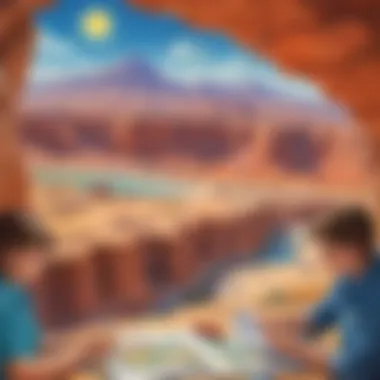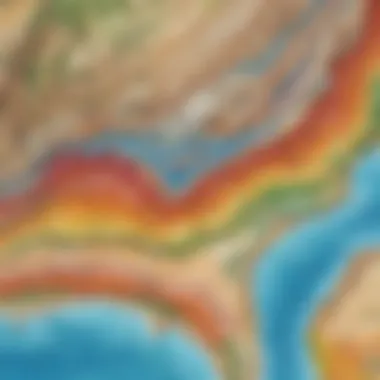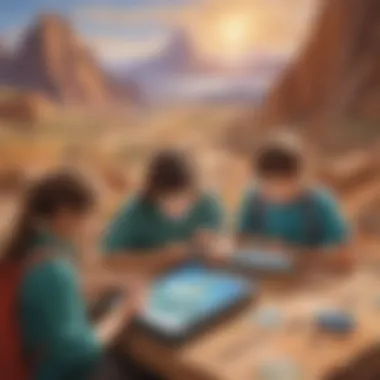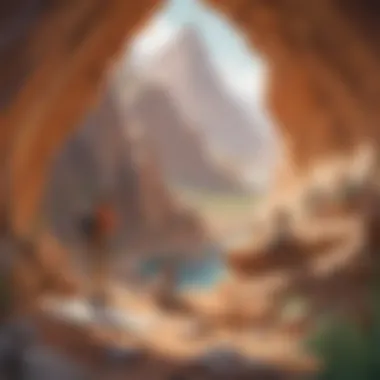Engaging Young Minds: Teaching Geology Creatively


Intro
Geology doesn’t just whisper the stories of our planet; it shouts them from the mountain tops and murmurs them from the ocean floors. When teaching geology, it’s essential to transform those geological tales into engaging learning experiences, especially for young minds. Children between the ages of six to twelve are naturally curious, eager to explore, and ready to soak up knowledge like a sponge. In this very special age, the right teaching methods can spark a lifelong fascination with the Earth and its wonders.
Throughout this article, we’ll delve into various methods to make geology appealing and memorable. This includes inquiry-based learning, where students ask questions, make predictions, and explore their findings. Plus, we will look at highly interactive strategies, such as utilizing technology and hands-on activities to get their little hands dirty—figuratively and literally. Just picture how an exciting geology lesson can evolve from rote memorization into a vibrant adventure!
Let’s embark on this engaging journey, unlocking the secrets of geology, while cultivating critical thinking and curiosity in our young learners.
Understanding Geology
Understanding geology is not merely an academic pursuit; it serves as a gateway to grasping the very fabric of our planet. At its core, geology encompasses the study of Earth’s materials, processes, and history. It’s about making sense of the mountains we gaze at, the soil beneath our feet, and the wonders that lie hidden beneath surface.
For those engaging in this subject, particularly young learners, geology fosters a sense of curiosity about the world. It connects them to essential concepts that describe how our planet operates. To teach geology effectively, it's vital to highlight its relevance, from the formation of ecosystems to the cycles that sustain life.
What is Geology?
Geology is the scientific study of the Earth, including its structure, composition, and the processes that shape its surface. This discipline draws from various sciences, such as chemistry, physics, and biology, to paint a detailed picture of our planet.
Simply put, geology can be thought of as the history book of Earth. This book reveals the secrets of ancient landscapes and the processes that have changed them over millions of years.
Rocks, minerals, fossils – these elements are just tip of the iceberg. Geology guides us to understand not only the physical features of the Earth but also the dynamics of natural events like earthquakes and volcanic eruptions. This kind of knowledge is foundational for students, particularly young minds curious about their environment. It opens doors to understanding ecosystems and the consequences of climate changes.
Importance of Geology in Everyday Life
The significance of geology stretches far beyond the classroom. In everyday life, geology is woven into the very fabric of our existence. Here are several ways that this discipline impacts us:
- Resource Management: Geology helps locate and manage natural resources like water, minerals, and fossil fuels. Understanding where these resources are found is crucial for sustainable development.
- Natural Disaster Preparedness: Knowledge of geological processes allows communities to better predict and prepare for earthquakes, landslides, and tsunamis. For example, in places prone to earthquakes, recognizing fault lines can save lives.
- Environmental Awareness: Geology teaches us about soil types and stability, influencing farming and land-use practices. This helps create a balanced approach to land conservation and agriculture.
- Cultural Heritage: Geology gives insight into significant historical sites. The unique formations can tell us about the ancient cultures that inhabited a given area or the events that shaped the land.
These elements underline why geology is not just an academic subject but an essential part of our daily lives. Understanding geology imparts not only knowledge but also a sense of responsibility to care for our planet. As young learners engage with these concepts, they cultivate a deeper connection to their surroundings, promoting environmental stewardship and a lifelong curiosity about the Earth.
"To explore the physical world is to understand one's place in its intricate web of connections."
By guiding students through the wonders of geology, educators plant the seeds for informed citizens who appreciate and safeguard our natural heritage.
Teaching Approaches in Geology
Teaching geology, especially to young learners, is like opening a treasure chest of knowledge about our Earth. The right approaches can make all the difference in nurturing an appreciation for this science, ensuring kids are not just passively absorbing facts, but actively engaging with the material. A well-rounded teaching strategy encompasses various methods that cater to the diverse ways students learn. By incorporating multiple approaches, educators can spark interest, enhance retention, and develop necessary critical thinking skills in geology.
Inquiry-Based Learning
Inquiry-based learning fosters a sense of wonder and curiosity about the Earth’s processes. Instead of merely presenting information, instructors encourage students to ask questions, think critically, and explore geological concepts through guided investigation. This method helps children grasp big ideas and deeper content through their own experiences. For instance, instead of telling students how rocks form, an educator might set up a mini-experiment where students can observe sedimentation using sand and water in clear containers. When they see how layers develop, it becomes a tangible concept that resonates with them.
"The greatest danger in times of turbulence is not the turbulence; it is to act with yesterday’s logic." — Peter Drucker
This quote emphasizes the importance of evolving our educational methods to maximize relevance and engagement.
Hands-On Activities
Nothing beats getting your hands dirty when it comes to learning geology. Hands-on activities are invaluable for young learners, providing an exciting way to experience geology in action. Simple exercises such as creating a model volcano or simulating an earthquake with Jell-O can allow students to visualize and comprehend processes that shape our planet.
Involving learners in projects like rock and mineral identification increases engagement and reinforces their understanding. You could organize a rock collection day where students bring in specimens and present them, discussing attributes like color, texture, and origin. This not only solidifies their knowledge but also fosters camaraderie as they share findings with peers.
Integration of Technology
In today’s digital world, integrating technology into geology education can heighten excitement and understanding. Utilizing applications that allow students to simulate geological phenomena makes complex concepts more accessible. For example, augmented reality apps bring geological environments to life right in the classroom, immersing students in different ecosystems or even historical geological events.
Digital storytelling tools also provide avenues for learners to express what they've discovered. They can create presentations or videos that share what they’ve learned about volcanoes or the rock cycle, tapping into their creativity while reinforcing their understanding.
Incorporating platforms such as Wikipedia, Britannica, or forums like Reddit can encourage students to dive deeper into topics of their interest and find additional information beyond the classroom walls. It is not just about consuming facts but also about engaging with the geology community online, promoting a broader understanding of the subject.
Engagement is essential when teaching young learners about geology, and these three approaches can significantly enhance their learning experience. Inquiry-based learning ignites curiosity, hands-on activities connect them with real-world applications, and technology provides fresh avenues for exploration. Such multifaceted strategies pave the path for deepening students’ understanding of Earth’s secrets.
Creating an Engaging Curriculum
Crafting an engaging curriculum for geology is crucial in igniting young minds' interest and curiosity about the earth. This journey goes beyond mere facts and figures; it's about creating a landscape of discovery, where students feel empowered and inspired to explore the world beneath their feet. An engaging curriculum encourages learners to appreciate the context and relevance of geology in their lives, making it an integral part of their education.
Identifying Key Geology Topics
When identifying key geology topics for young learners, it's important to strike a balance between fundamental concepts and the interests of the children. Topics like the rock cycle, tectonic plates, fossils, and minerals can serve as gateways into the broader geological concepts while keeping the material relatable. Selecting topics that resonate with their everyday experiences, such as local geological features or famous natural landmarks, makes the learning process more engaging.
- Rock Types: Understanding igneous, sedimentary, and metamorphic rocks lays the foundation for more advanced topics.
- Natural Disasters: Learning about earthquakes and volcanoes connects real-world events to classroom learning, making geology feel vital and close to home.
- Environmental Geology: Discussing the role of geology in resource management and environmental protection can cultivate responsible future citizens.
Developing Interactive Learning Materials
To captivate the minds of young learners, interactive materials are essential. Activities that involve hands-on experience not only enhance absorption of knowledge but also cater to various learning styles. For instance, science kits containing rock samples can invite students to touch and examine their characteristics firsthand.
- Worksheets and Quizzes: Structure them to include fun scenarios or puzzles based on geological concepts.
- Models and Diagrams: Crafting three-dimensional models of the earth’s layers or tectonic plates can be both educational and fun.
- Games: Creating geology-themed board games or interactive apps can enrich the learning experience while promoting teamwork and critical thinking.
Utilizing Visual Aids


Visual aids play an essential role in geology education, as they help to simplify complex information and aid retention. Children are naturally drawn to images, diagrams, videos, and other visual formats. Leveraging these tools makes it easier to convey intricate geological processes and concepts in a digestible manner.
- Charts and Infographics: Simple yet effective, they can illustrate topics such as rock formation processes or types of fossils.
- Videos: Short documentaries about geological phenomena can invoke curiosity and provide real-world context.
- Field Images: Pictures from iconic geological sites, like the Grand Canyon or Mount St. Helens, can serve as a powerful engagement tool.
An engaging curriculum not only informs students about geology but also inspires a sense of wonder and exploration. Whether through visual aids, interactive materials, or carefully chosen topics, the ultimate goal is to make learning geology an exciting adventure.
By weaving together these elements, educators can establish a curriculum that captures the essence of geology while encouraging students to explore and appreciate the wonders of our dynamic planet.
Engaging Young Learners
Engaging young learners in geology is essential for nurturing both their curiosity and understanding of the Earth. A subject like geology, which explores not only the physical structure of the Earth but also various processes shaping our planet, can capture the imaginations of children when approached with the right techniques. Teaching geology becomes a transformative journey when educators find ways to connect with young minds, making the learning process joyful and memorable.
Being attentive to individual learning styles becomes a cornerstone in creating this engaging educational experience. Some children thrive on visual stimuli, while others might find kinesthetic activities most impactful. By offering diverse methods of engagement, such as hands-on experiments or vivid storytelling, an educator can amplify interest and foster deeper understanding.
Fostering Curiosity and Exploration
Curiosity is the engine that drives learning. When young learners feel free to explore, ask questions, and make observations, they become active participants in their own education. This can be cultivated through various strategies, one of which includes encouraging spontaneous inquiries. Teachers can create a wonder wall in the classroom, where students post questions about the natural world that pique their interest. This not only validates their curiosity but also fosters a collective inquiry that builds a sense of community in learning.
Moreover, encouraging exploration of the outdoors is an incredibly effective method for sparking interest. Simple activities like rock collecting during a nature walk can ignite passions for geology. It allows children not just to see but to touch and feel the Earth's materials firsthand.
"The earth has music for those who listen.” - Shakespeare
Children can be taught to listen to the world. Each rock, each layer of soil, tells a different story. By teaching them how to observe and appreciate these natural wonders, we equip them with a mindset rooted in inquiry and exploration.
Incorporating Stories and Legends
Stories hold a special place in human culture and learning, and when integrated into geology lessons, they can take on a new life. Legends about mountains, rivers, and landscapes can be powerful tools for engagement. For instance, introducing the tale of how the Grand Canyon was formed alongside geological facts can create an emotional connection with the material.
Incorporating storytelling transforms dry facts into vibrant narratives that young learners can relate to and remember. This could mean discussing Native American lore about volcanic mountains or using ancient myths to explain natural disasters like earthquakes. Through these stories, children not only learn about geological processes but also gain insights into human perspectives on nature's power and beauty.
Additionally, teachers can encourage students to create their own stories based on geological concepts or local legends. This not only reinforces their learning but also helps them internalize complex ideas by translating them into their own words. By combining geological information with stories, the curriculum becomes a rich tapestry that blends science and imagination—crucial elements for keeping young learners engaged.
Field Trips and Experiential Learning
Field trips represent a dynamic avenue for teaching geology, providing learners with the chance to step outside the classroom and directly engage with the Earth’s features. Such immersive experiences hold significant merit as they cultivate a deeper understanding of geological concepts by allowing students to observe, analyze, and interact with real-world examples. By venturing into parks, canyons, or even rocky shores, young learners can connect geological theory to tangible observations, ultimately enhancing their educational experience.
The importance of field trips in geology education cannot be overstated. They not only supplement classroom learning but also spark curiosity and ignite a passion for the natural world. When students witness the rugged textures of rocks or the flow of a stream, they make connections that no textbook can replicate. For example, observing sediment layers in a nearby outcrop can help them grasp concepts like stratigraphy with an immediacy that is palpable and lasting.
Planning Geological Field Trips
When it comes to planning geological field trips, several factors must be taken into account. Here’s a checklist of essential considerations:
- Destination Selection: Choose locations rich in geological significance—local quarries, riverbanks, or coastal areas. Each site can offer unique educational opportunities based on its features.
- Safety Protocols: Ensuring the safety of all students is paramount. Conduct a risk assessment to scout potential hazards, such as unstable paths or strong currents.
- Objectives: Define clear learning goals for the trip. Whether it’s understanding rock formation, studying erosion, or simply enjoying nature, having objectives helps structure the experience.
- Engagement Strategies: Incorporate activities or prompts for students to engage with. Encourage them to collect samples, take notes, or sketch observations to reinforce learning.
- Follow-Up Activities: Plan post-trip discussions or projects that allow students to share their findings and reflect on their experiences. This can keep the learning alive long after the trip is over.
Benefits of Experiential Learning
The benefits of experiential learning through field trips are profound and multifaceted.
- Enhanced Retention: Students tend to remember what they see and do better than what they read. The tactile experience of handling geological specimens solidifies understanding.
- Critical Thinking Development: Being in the field prompts learners to ask questions and make observations. They start to think like scientists, analyzing data in real-time and enhancing their critical thinking skills.
- Promotes Teamwork: Learning outdoors often involves group activities that foster social skills. Students collaborate, share ideas, and work together, both academically and socially.
- Inspiration and Enthusiasm: The excitement of discovering nature firsthand can ignite a passion for geology, potentially inspiring future careers.
"To see the Earth’s layers, to pick up a rock, and to truly feel the world under your feet is lesson far richer than words can offer."
In essence, field trips in geology education hold the key to unlocking a learner's potential. They provide not only knowledge but also an appreciation of the complexities that shape our planet, making lessons memorable and engaging.
Assessment and Feedback
Assessment and feedback play a crucial role in teaching geology effectively. As educators, the goal is not just to impart knowledge but to ensure that students grasp and can apply what they’ve learned about the Earth and its processes. Evaluating understanding and providing constructive feedback helps shape the learning experience, making it more personalized and impactful.
One of the key elements in assessing young learners is understanding that each student might grasp geological concepts at different paces. Incorporating various assessment methods allows teachers to cater to these differences. Interactive quizzes and hands-on projects can help determine where a child excels or struggles. Moreover, informal assessments, such as group discussions or observational notes during field trips, can reveal a lot about student engagement and comprehension.
Evaluating Student Understanding
Evaluating student understanding in geology involves more than just test scores and grades; it should encompass a holistic view of a learner’s grasp of the subject. This can take shape in different forms:
- Observation: Keeping track of how a child engages with activities, such as collecting rocks or identifying minerals, can reveal their understanding on different levels.
- Peer Discussions: Encouraging children to talk about their findings with peers not only aids in reinforcing their knowledge but also gives teachers insight into their comprehension.
- Creative Assignments: Assigning projects that require students to create models of geological formations allows them to apply what they’ve learned creatively. For example, using clay to model the layers of Earth can cement their understanding of stratification.
Incorporating a diverse range of evaluation strategies ensures that students are not just memorizing facts but are genuinely understanding and applying geological concepts.
Providing Constructive Feedback
Feedback should be seen as a guiding tool rather than a means of judgment. Constructive feedback helps foster a positive learning environment. It provides the student with information on what they did well and where they can improve. Here’s how to offer it effectively:
- Be Specific: Instead of saying, "Good job," a comment like, "Your rock identification was impressive, but be sure to explain the mineral composition more clearly next time," gives more clarity on areas to focus on.
- Focus on Growth: Use feedback to encourage a growth mindset. Phrasing feedback in a way that reflects on future possibilities can motivate students. For instance, "With a little more practice in identifying geological processes, you'll grasp the concept even better!"
- Encourage Reflection: After a project or lesson, invite students to reflect on their work. Just asking them, “What did you learn?” or “What would you do differently next time?” can open avenues for personal growth.
The essence of constructive feedback lies in guiding students towards their potential, emphasizing that learning is a journey.
Encouraging Critical Thinking
Teaching geology isn't just about memorizing rock types or learning about tectonic plates; it's also about fostering critical thinking among young learners. In today’s world, the ability to analyze, evaluate, and synthesize information is more crucial than ever. When children engage with geology, they are not only absorbing facts but also learning to question assumptions and draw connections between concepts. This skill set is vital in a field where new discoveries are frequent and often challenge established ideas.


One of the primary elements in encouraging critical thinking is to give students the tools to problem-solve. Instead of simply teaching mineral compositions, educators can present real-world scenarios that require students to analyze geological data and make informed predictions. By doing this, students learn how geological processes affect the everyday world. For instance, discussing the impact of a volcanic eruption on an area can have students contemplate answers based on data - they can analyze maps that illustrate past eruptions and draw upon that knowledge to understand potential risks more deeply than if they’d only listened to lectures about volcanoes.
"Critical thinking is more than just finding the right answer; it’s about asking the right questions."
Among the invaluable benefits of this approach is that it allows children to use their reasoning skills actively. This not only solidifies their understanding of geological concepts but also paves the way for a mindset that embraces inquiry and curiosity. Involving students in guided group discussions about geological phenomena encourages them to articulate their thoughts and consider diverse viewpoints, further enriching their educational experience.
Promoting Problem-Solving Skills
When we discuss problem-solving skills, we’re really diving into how children can tackle geological issues like a scientist. For example, an activity could involve a mock investigation of a landslide. Students can analyze the terrain, look at soil samples, and suggest preventive measures. Not only does this engage critical thinking, but it also encourages teamwork and communication. Whether they’re debating the best course of action for a hypothetical event or devising solutions to mitigate geological hazards, these exercises build a solid foundation for their analytical capabilities.
Stimulating Analytical Thinking
With analytical thinking, students learn to dissect and evaluate geological information critically. This can be strengthened through the incorporation of interactive tools, such as geological simulation software or data analysis programs that allow students to visualize different geological scenarios. By interpreting data trends and understanding the underlying geological processes, young learners become adept at connecting the dots. Students might analyze how water erosion shapes landscapes over time, fostering a deeper appreciation for the planet's complexity.
Encouraging analytical thinking not only makes learning more engaging but also leaves kids with skills that extend beyond the classroom. They learn to scrutinize data, ask questions, and advocate for solutions. This more profound understanding of geology and its applications enables them to think not only like students but as budding geologists and informed citizens.
Geological Concepts for Young Minds
Understanding the Earth’s structure and processes is fundamental for young learners. Teaching geological concepts not only sparks interest in science but also lays a groundwork for appreciating our planet's past, present, and future. When children grasp these concepts, they start to make connections with the environment around them. These insights can nurture a sense of stewardship, empowering them to take care of the Earth.
Rocks and Minerals
Rocks and minerals are the building blocks of our planet. They come in various shapes, colors, and sizes, each with its own unique story to tell.
Importance of Rocks and Minerals
They teach children about the processes that form the world around them. This can be fascinating for children because:
- Variety: Rocks and minerals form a diverse world. For instance, igneous rocks, formed from cooled magma, differ greatly from sedimentary rocks, which come from compacted materials.
- Real-Life Applications: Understanding these concepts helps kids relate to their world. For example, they get to know the importance of granite in kitchen countertops or quartz in electronics.
- Hands-On Learning: Activities like collecting samples or testing rock hardness can really engage students. It makes them feel like real scientists.
You can dive deeper into this topic by encouraging fun experiments. Make a simple rock collection or even a mineral identification game. This not only enhances memory but also makes learning enjoyable.
Earthquakes and Volcanoes
Earthquakes and volcanoes, on the other hand, bring about powerful images in children's minds. These geological phenomena are often dramatized in films, but it’s crucial to ground their understanding in science.
Why Teach About Earthquakes and Volcanoes?
They help learners appreciate the dynamic nature of the Earth:
- Understanding Forces: Children learn about tectonic plates and how they interact. For instance, the Ring of Fire is a fascinating concept that shows where many volcanic eruptions occur due to these plates.
- Safety Awareness: Knowledge about earthquakes can prep kids on how to stay safe in case of an event. Simple drills can be important and increase actual comprehension.
- Impact on Ecosystems: Discussing how volcanic eruptions can truly reshape landscapes can inspire children to think about ecological impacts.
Practicing safety drills, talking about real events, and possibly visiting a local geological site can make this learning come alive. Don’t forget to incorporate visual aids and storytelling.
The Rock Cycle
The rock cycle is a vital concept when teaching geology. It’s like nature’s recycling program, showing how rocks transform from one type to another.
Key Aspects of the Rock Cycle:
- Continuous Process: The rock cycle emphasizes change—nothing is permanent in geology. Kids find it intriguing to see how sedimentary rocks can change into metamorphic rocks, for instance.
- Connecting Processes: Understanding the rock cycle connects the previously discussed concepts. Kids can see how minerals become rocks and how various geological forces intertwine.
- Encouragement of Curiosity: Once students learn about the cycles, they often want to know how they can observe these processes. This can lead to projects or school events centered around cycles and transformations.
In essence, using diagrams or simple animations can help visualize these processes. Children might find that engaging with the cycle allows them to draw parallels with real-life offensive cycles—like the seasons!
"Teaching kids about geological concepts is not just filling their heads with facts; it’s about shaping their understanding of Earth as a living, breathing entity."
The concepts of rocks, earthquakes, volcanoes, and the rock cycle create a rich tapestry of ideas that excite young minds. Engaging through hands-on activities, stories, and visual aids nurtures their curiosity effectively. By framing geology in ways that relate to their daily lives, educators inspire a deeper appreciation for our planet and its intricacies.
Incorporating Real-World Examples
In teaching geology, using real-world examples isn't just an add-on; it’s fundamental. By connecting geological concepts to actual events or observable features, educators can bring dry textbooks to life, igniting curiosity and engagement among young learners. Here are some specifics on why this is crucial:
- Contextual Learning: Real-world examples help put geological processes into context. Instead of just teaching about erosion, a teacher could explain how the Grand Canyon was formed over millions of years. This kind of storytelling makes the subject relatable, giving students a tangible frame of reference.
- Connecting Science to Life: Children are naturally inquisitive, and they often ask questions like, "Why is the sky blue?" or "What causes earthquakes?" By using real-world examples, you can address these queries effectively. For instance, discussing the impact of recent volcanic eruptions not only covers geological concepts but also informs about safety and environmental issues.
- Encouraging Observation: When kids see a geological feature in their surroundings—be it a hill, a rock formation, or a river—they develop observation skills. Teachers can encourage students to keep a geological journal, noting down local formations and linking them to lessons in class.
- Inspiring Future Geologists: When children learn about significant geological events, they often become inspired to explore careers in science. Notable examples, such as the eruption of Mount St. Helens or the discovery of dinosaur fossils in Alberta, Canada, can spark dreams of becoming scientists, geologists, or paleontologists.
"Understanding our world means understanding its past—geology is the key to unlock that history."
Real-world examples also come with responsibilities. It is important to present these examples ethically, ensuring the information is balanced and educational without overly sensationalizing events, especially when discussing natural disasters. Educators must consider the age of the audience, emphasizing the wonder of geology while ensuring a respectful approach to sensitive topics.
With all that in mind, let’s dive into specific real-world events that can serve as powerful teaching tools.
Case Studies of Geological Events
Investigating geological events through case studies offers a unique opportunity for students. Consider the following:
- The 2004 Indian Ocean Tsunami: This devastating event showcases the importance of tectonic plates. By explaining the science behind tsunamis, teachers can help learners understand why some areas are more vulnerable than others and discuss preparedness.
- The Formation of Iceland: As a geologically young island formed by volcanic activity, Iceland serves as a vivid case study. Students can explore how the Mid-Atlantic Ridge is a result of plate tectonics and witness firsthand some of Earth's most exciting geological processes.
Exploring Local Geology
Engaging children with the geology in their backyard can be an effective teaching strategy. Local geological features often hold fascinating stories. For example:
- Rock Types: If a school is near a mountain range, teachers can organize hikes where students learn to identify rock types and formations, linking them to their history and age.
- Rivers and Erosion: A nearby river can become a living laboratory for examining erosion. Students can measure how fast the river flows, collect sediment samples, and even build small models to visualize erosion processes.


In summary, incorporating real-world examples into geology education enriches learning experiences by providing context and relevance. By tapping into both significant geological events and local features, teachers can foster a deeper understanding of the Earth, nurturing a generation that is curious and informed.
Resources for Teaching Geology
The selection of resources for teaching geology is crucial, especially when aiming to capture the imaginations of young learners. Providing quality materials not only enhances the learning experience but also fosters the development of a deeper understanding of Earth’s complexities. The right resources can serve as gateways that connect natural phenomena to classroom concepts, making geology more relatable and tangible for children.
Books and Reference Materials
Books and reference materials are often the backbone of any educational endeavor. They provide structured content that can be carefully woven into a curriculum. For children, well-chosen books—such as National Geographic Kids: Earth Science or The Magic School Bus: Inside the Earth—can transform dry facts into exciting adventures. Here are several aspects to keep in mind:
- Age Appropriateness: Tailor selections to the reading level and comprehension abilities of your students. Younger readers benefit from colorful illustrations and simplified language, while older children can handle more complex themes.
- Varied Perspectives: Look for books that present different viewpoints within geology. From the formation of mountains to the impact of erosion, a wide range of topics keeps curiosity alive.
- Integration of Activities: Consider incorporating books that include activities or experiments. This hands-on approach reinforces knowledge and can cement a child’s learning.
In addition to children’s books, educators should also possess reference materials that succinctly cover significant geological concepts. Textbooks like Geology for Kids can serve as handy guides not only for teaching but also for providing accurate information during discussions.
Online Platforms and Tools
In today’s digital age, online platforms offer unprecedented access to geological knowledge and teaching resources. Websites like National Geographic Education provide educators with lesson plans, interactive maps, and video resources that can easily slot into any teaching strategy.
Here are key benefits to utilizing online tools:
- Interactive Learning: Websites often feature interactive simulations and games that engage children in a fun way. These digital platforms can illustrate principles like plate tectonics or volcanic eruptions with visuals that textbooks cannot match.
- Access to Current Events: Online resources often include updates on geological events around the world. Whether it’s a recent earthquake or a newly discovered mineral, current news keeps content fresh and applicable.
- Collaboration: Utilize platforms like Reddit to engage with a community of geology educators. You can share ideas, gather reactions to teaching methods, or simply ask for resources others find valuable.
With a thoughtful selection of both print and digital resources, teaching geology becomes not just a task, but rather a vibrant exploration that inspires awe and curiosity in young minds. Every resource should ideally align with the goal of nurturing a profound interest in the Earth’s secrets, ensuring that students can explore concepts that extend well beyond the classroom walls.
The Role of Parents and Caregivers
In the realm of geological education, the involvement of parents and caregivers cannot be overstated. Their role is pivotal in nurturing a child's curiosity about the Earth and its processes. By engaging with their children in geological discussions, parents can strengthen their understanding while fostering a bond built on learning. Moreover, active participation at home leads to the cultivation of a child's critical thinking skills and a greater appreciation for the natural world.
Parents and caregivers serve as primary educators outside the traditional classroom setting. Their influence can spark a lifelong interest in geology, encouraging children to explore various geological concepts and phenomena. This section will elaborate on how they can effectively support learning at home and promote outdoor exploration.
Supporting Learning at Home
To facilitate learning within the confines of home, here are some effective strategies parents can employ:
- Create a Geology Corner: Dedicate a section of the home to geological resources. Display rocks, minerals, maps, and books related to Earth sciences. This continuous exposure helps solidify concepts introduced in school.
- Use Everyday Conversations: Discuss geological features during daily activities. For example, when driving, point out hills, valleys, or rock formations, and ask questions like, "What do you think caused that hill to be formed?" Such questions encourage children to think critically about their environment.
- Interactive Learning Tools: Make use of online platforms or educational apps focused on geology. Websites like Britannica or Wikipedia offer valuable resources that can complement what children learn in school.
- DIY Science Experiments: Simple experiments can help illustrate geological principles. For instance, creating erosion models with sand can demonstrate how water shapes landscapes. This hands-on approach makes learning tangible and memorable.
By integrating these practices into daily life, parents can lay a strong foundation for their child's geoscientific knowledge.
Encouraging Outdoor Exploration
Exploring the outdoors can greatly enhance a child's understanding of geology. Here's how parents and caregivers can encourage such adventures:
- Nature Walks: Plan regular trips to local parks, nature reserves, or geological sites. Encourage kids to observe and inquire about different rock types, soil composition, and plant life. These outings could turn into a treasure hunt, with children searching for different geological features.
- Geocaching: This modern-day scavenger hunt utilizes GPS-enabled devices to find hidden containers. It adds an element of excitement to outdoor exploration while teaching children to appreciate their surroundings.
- Local Museums and Science Centers: Visits to geology exhibits in museums provide a wealth of information. Many institutions offer programs tailored for children, allowing interactive learning experiences related to the Earth sciences.
- Seasonal Activities: During different seasons, geological features can change. Observing how the landscape shifts with weather can spark discussions about erosion, sedimentation, and other geological processes.
Remember, engaging children with their environment not only educates them about geology—it's also about instilling a sense of wonder and responsibility towards the Earth.
Future of Geology Education
The future of geology education holds tremendous potential for shaping how young learners interact with and understand Earth’s intricate systems. As we consider the trajectory of this field, it becomes increasingly vital to adapt teaching methods and resources to resonate with the digital age's demands. A key element in this adaptation is personalized learning, which values each learner's unique journey. This approach not only creates more empathetic, responsive educational environments but also caters to various learning styles, ensuring that every child finds a way to connect with geology.
One significant component of future geology education involves incorporating interdisciplinary studies, where subjects like geography, environmental science, and physics intertwine with geology. Doing so enriches students’ comprehension and reveals the broader scientific context. It prepares students to engage not just with geology but also with the urgent challenges facing our planet, like climate change and resource management. By connecting concepts, educators can spark interest in students and help them see the relevance of geology in their daily lives.
Furthermore, as technology continues to advance, the inclusion of digital tools becomes paramount. This shift can boost engagement and foster a deeper understanding of geological processes. From interactive simulations that allow students to visualize tectonic plate movements to virtual reality excursions that mimic field trips through volcanic landscapes, technology presents exciting opportunities for immersive learning experiences that can captivate young minds.
"The best teaching strategies for the future will provide learners with hands-on applications that spark their curiosity and creativity."
Trends in Geology Teaching
The trends in geology teaching point towards a more dynamic, hands-on, and inquiry-based education. Several noteworthy trends include:
- Blended Learning: This hybrid model successfully blends traditional teaching with online resources, providing flexibility. Students can explore geology through interactive platforms while still engaging in hands-on activities.
- Flipped Classrooms: In this model, students learn foundational concepts through video lectures at home, freeing up classroom time for deeper discussions and practical activities, allowing learners to explore geological phenomena in a collaborative environment.
- Project-Based Learning: By focusing on projects grounded in real-world geological issues, students cultivate problem-solving skills and teamwork, essential for the modern workplace.
Adapting to these trends can make geology classes more captivating and relatable to students, helping them to draw connections to current events and local environments.
Innovations in Geology Resources
Innovations in geology resources are game-changers in how we teach young learners about Earth's dynamic systems. Some notable innovations include:
- Augmented Reality (AR) Apps: These resources provide engaging ways to visualize geological features and processes. For instance, students can point their devices at rocks in their environment and learn about their formations through AR overlays.
- Online Collaborative Platforms: Tools that allow students to work together on geological models or projects foster cooperation and deeper understanding in an age where digital interaction is routine.
- Interactive Websites: Websites filled with engaging activities, simulations, and video content transform the learning experience. Children can conduct virtual experiments and see real-time results, offering a hands-on approach that suits tech-savvy learners.
These innovations not only make learning easier but also allow students to engage more deeply with the material, ensuring they absorb the critical concepts needed to navigate future explorations in geology.
Epilogue
Recapping the teaching strategies for geology highlights a subject that is more than just a collection of rocks, minerals, and earth processes; it embodies a gateway to understanding our planet and the broader cosmos. Teaching geology effectively has far-reaching implications not just for students, but for society at large. Here are some specific elements to consider regarding the importance of teaching geology:
- Relevance to Everyday Life: Understanding geological principles aids in recognizing the environmental issues that affect our daily lives, such as climate change, resource management, and natural disasters. This awareness fosters responsible citizens who can make informed choices.
- Encouraging Curiosity: The wonders of the Earth ignite a child’s imagination and curiosity. Parents and educators can tap into this innate wonder by emphasizing interactions with geology in engaging ways—be it through storytelling, outdoor excursions, or using modern technologies.
- Integration of All Disciplines: Geology connects with history, biology, physics, and chemistry, creating a rich interdisciplinary context. This not only enhances critical thinking but also appeals to various interests among learners.
- Workforce Preparation: The future requires professionals in geology and related fields to tackle problems such as mining, petroleum extraction, and environmental restoration. Early education builds a foundation for future specialists.
- Development of Analytical Skills: Engaging in geology enhances students' analytical skills which are critical for problem-solving. This discipline emphasizes observation, hypothesis formation, and testing, forming a robust framework for academic and real-life challenges.
"Teaching geology isn’t merely imparting knowledge; it’s about sculpting the minds that will shape our world's future."
Recapping the Importance of Teaching Geology
Teaching geology equips young learners with essential skills and knowledge that transcend the classroom. When children understand the intricacies of the Earth beneath their feet, it empowers them to think critically about the world around them.
- Foundational Knowledge: Introducing the fundamental concepts of geology provides a framework that supports further scientific education.
- Connection to Nature: Experiences such as field trips help kids experience geology firsthand, establish a bond with the environment, and develop responsible stewardship of the Earth.
- Innovation and Technology: Geology is an evolving field that increasingly intersects with technology. Familiarity with geology is thus not just about the past but also about a future where data analysis and digital tools are pivotal.
- Life Skills: Geology fosters skills like teamwork, as group projects may require collaboration and discussion.







